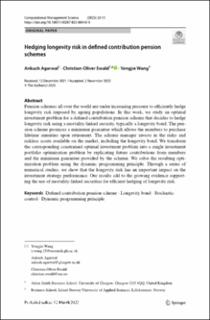| dc.contributor.author | Agarwal, Ankush | |
| dc.contributor.author | Ewald, Christian Oliver | |
| dc.contributor.author | Wang, Yongjie | |
| dc.date.accessioned | 2023-09-22T13:31:34Z | |
| dc.date.available | 2023-09-22T13:31:34Z | |
| dc.date.created | 2023-03-29T15:23:25Z | |
| dc.date.issued | 2023 | |
| dc.identifier.citation | Computational Management Science. 2023, 20 (1), 11. | en_US |
| dc.identifier.issn | 1619-697X | |
| dc.identifier.uri | https://hdl.handle.net/11250/3091435 | |
| dc.description | © The Author(s) 2023. This article is licensed under a Creative Commons Attribution 4.0 International License. | en_US |
| dc.description.abstract | Pension schemes all over the world are under increasing pressure to efficiently hedge longevity risk imposed by ageing populations. In this work, we study an optimal investment problem for a defined contribution pension scheme that decides to hedge longevity risk using a mortality-linked security, typically a longevity bond. The pension scheme promises a minimum guarantee which allows the members to purchase lifetime annuities upon retirement. The scheme manager invests in the risky and riskless assets available on the market, including the longevity bond. We transform the corresponding constrained optimal investment problem into a single investment portfolio optimization problem by replicating future contributions from members and the minimum guarantee provided by the scheme. We solve the resulting optimization problem using the dynamic programming principle. Through a series of numerical studies, we show that the longevity risk has an important impact on the investment strategy performance. Our results add to the growing evidence supporting the use of mortality-linked securities for efficient hedging of longevity risk. | en_US |
| dc.language.iso | eng | en_US |
| dc.rights | Navngivelse 4.0 Internasjonal | * |
| dc.rights.uri | http://creativecommons.org/licenses/by/4.0/deed.no | * |
| dc.subject | defined contribution pension scheme | en_US |
| dc.subject | longevity bond | en_US |
| dc.subject | stochastic control | en_US |
| dc.subject | dynamic programming principle | en_US |
| dc.title | Hedging longevity risk in defined contribution pension schemes | en_US |
| dc.type | Peer reviewed | en_US |
| dc.type | Journal article | en_US |
| dc.description.version | publishedVersion | en_US |
| dc.subject.nsi | VDP::Samfunnsvitenskap: 200::Økonomi: 210 | en_US |
| dc.source.pagenumber | 1-34 | en_US |
| dc.source.volume | 20 | en_US |
| dc.source.journal | Computational Management Science | en_US |
| dc.source.issue | 1 | en_US |
| dc.identifier.doi | 10.1007/s10287-023-00440-8 | |
| dc.identifier.cristin | 2138237 | |
| dc.source.articlenumber | 11 | en_US |
| cristin.ispublished | true | |
| cristin.fulltext | original | |
| cristin.qualitycode | 1 | |

